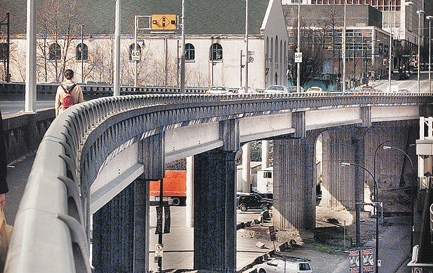Derrick Penner
Sun

Georgia and Dunsmuir viaducts could be eliminated, but a new way to deal with traffic would have to be found. Photograph by: Ian Lindsay, Vancouver Sun, Vancouver Sun
Vancouver Coun. Geoff Meggs said he has heard a lot of enthusiastic response to the idea of tearing down the Georgia and Dunsmuir viaducts since he re-raised the idea a couple of weeks ago.
However, the thought has also raised some anxieties among land owners on the eastern edge of downtown Vancouver.
While eliminating the elevated concrete roadways would be esthetically pleasing for the downtown neighbourhood, the city wouldn’t be able to do it without finding a way to deal with the traffic that the routes now carry.
“The first concern I hear is from people worried about traffic connections,” Meggs said in an interview.
“And we’ve always made it clear we’re not going to eliminate those, but thought they could be redone.”
Meggs brought up the idea of removing the viaducts in early March, right after the 2010 Winter Games, during which both viaducts were closed.
City staff now have started preparing a request for proposals to study the possibility of closing the viaducts.
Meggs said the Olympic closures demonstrated what the city could be like without them, so maybe it was time to look at closing the viaducts to help promote walking, cycling and transit use. “If you said a few year sago that we were going to close the viaducts, people would have said that would paralyse the city,” Meggs said.
However, the Olympic-period closure might not be the best real demonstration of what life without the viaducts might be like, Michael Ferreira, a development consultant with the firm Urban Analytics, suggested.
Ferreira said enough Vancouverites left town during the Olympics that “it was almost a pleasure going downtown.”
He said that maintaining the flow of traffic, not only for commuters but also for the delivery of goods and materials, is the critical factor.
“I’m not sure how you would reroute that traffic so other routes wouldn’t become a congested nightmare,” he said.
Of particular concern to the company that owns the Vancouver Canucks and GM Place is what kind of accommodation could be made for its access points to the stadium, which depend on the viaducts being there.
“When you design, for all stadiums, it’s a very delicate process to make them work for people coming in and going out,” David Negrin, president of Aquilini Development and Construction, said in an interview.
Negrin said the Aquilini Group is planning a new office tower that would sit at the southwest corner of GM Place, which would have its main lobby at the level of the Georgia Viaduct.
“It’s difficult to comment,” he said. “We haven’t seen anything in terms of what the city’s thinking.”
However, Ferreirra admitted that removing the viaducts could have some advantages by removing structures that effectively cut Northeast False Creek off from Chinatown and the Downtown Eastside.
He said the SkyTrain guideway would be much easier to bridge than the two elevated roads.
“From an esthetic perspective, it would absolutely be nicer not to have [the viaducts] there,” he added.
Meggs said that removing the viaducts would raise questions about what to do with the land adjacent to them: Allow development or use it for parkland.
Regardless of the decision, Meggs said there would be contaminated soil issues to deal with in what was once a heavily industrialized zone of Vancouver.
Peter Webb, vice-president of development for Concord Pacific, the company that developed the nearby former Expo 86 lands, said the idea of tearing down the viaducts is intriguing, but his company would have to see more information about how the city would do it before forming an opinion on whether it would be a good idea.
Concord Pacific has one development property sandwiched between the viaducts which could potentially be affected by such a move, Webb said.
The company also has four market and six non-market development sites on False Creek that face the viaducts.
“It is a point of interest,” Webb said. “I’m not sure how we feel about it, so we really do support the study to find out if it is a good idea or not.”
© Copyright (c) The Vancouver Sun
